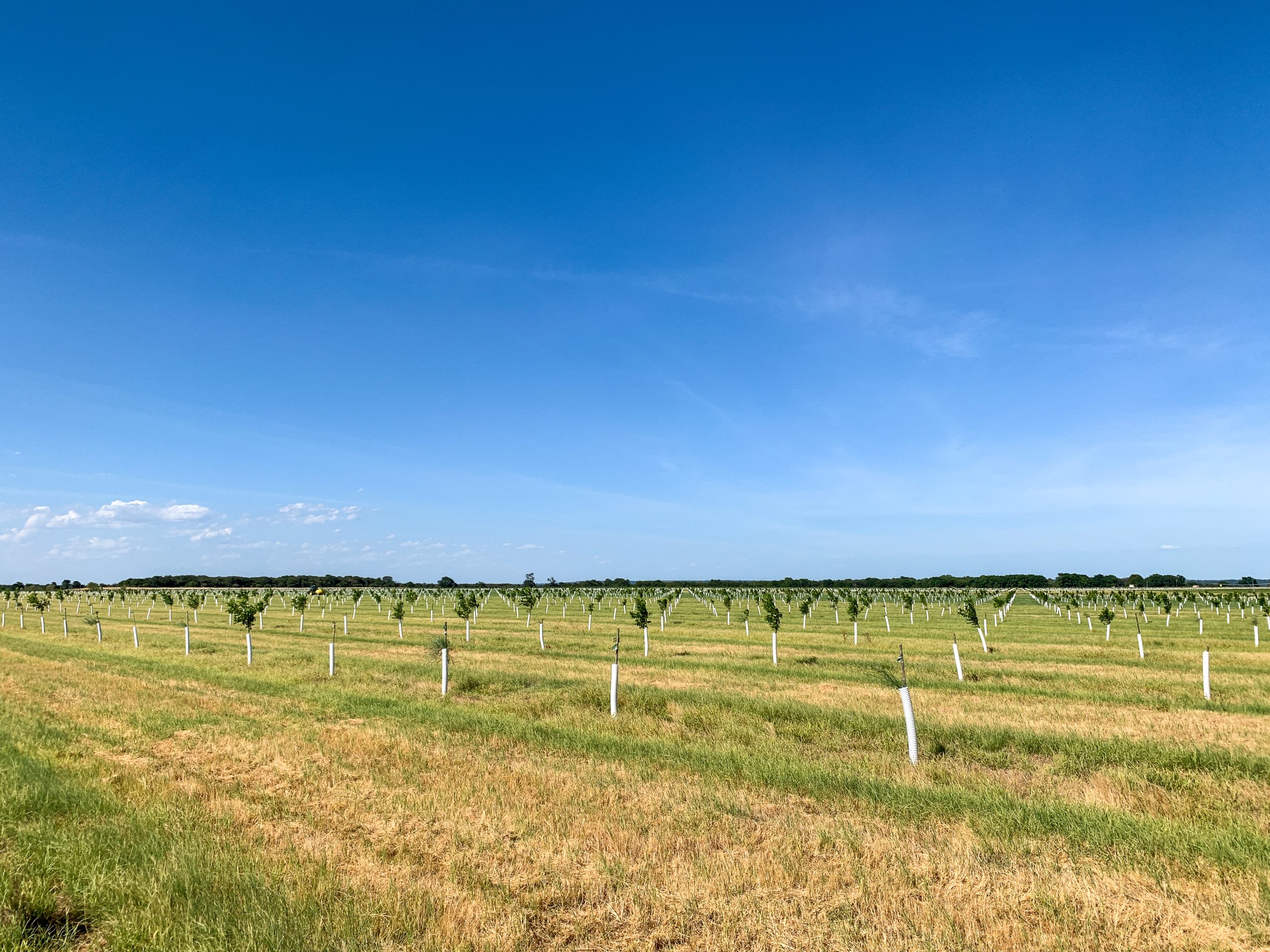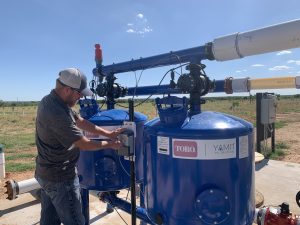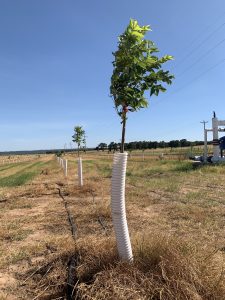Raptor Ag’s Giant Leap into Pecan Growing
Backed by investors, Raptor Ag dived straight into pecan growing by planting over 100,000 trees at the beginning of 2022. This is just the beginning.

Outside Marietta, Oklahoma, near the Red River, Raptor Ag planted 100,600 trees on 1,040 acres over five weeks in January and February 2022. This is just one of the three farms with young trees in late July. (Photo by Catherine Clark)
“I’ve been around for a while, and [when] they told me how many trees, I had to take a step back. I was like, ‘Ok. That’s never been done,’” says Brian Ladner II, the area manager for one of Raptor Ag’s three pecan farms on its property near the Red River west of Marietta, Oklahoma. “Australia, Mexico, America, anywhere they’re growing pecan—I have never heard of somebody trying to plant that many trees in one year—let alone two months.”
A fourth-generation pecan farmer, Ladner grew up in the area and continues to grow primarily native pecans and some improved varieties with his father on the family’s nearby farm. Before landing his job with Raptor Ag, Ladner was preparing to head back out to the oilfield when he was approached with the opportunity to be an Area Manager. He was among the team to help plan and coordinate the planting of 100,000-plus pecan trees.
“It was controlled chaos at first,” Ladner says. “Nobody has tried to plant this many trees in one go, and we were in a short timeframe. At first, it took us a couple of weeks to get through the kind of rocky logistical nightmare. As it progressed, it was just clockwork. Once we finally got rolling, it was an ungodly amount of trees we were planting at one time every day.”
With these plantings, the company has become—to the best of its knowledge—the largest pecan grower in the state of Oklahoma, and the company plans to continue planting in the coming months and years. So, what is Raptor Ag? And most importantly, why did the company choose pecans?
It all began with CEO Chris Eubanks. Eubanks has worked in agriculture for over 20 years and owns his own agricultural consulting and marketing firm. About nine years ago, while working in Oregon for some time, he became curious about why there were so many hazelnut orchards in Oregon. His curiosity grew when Oregon State University released new varieties. Seeing an opportunity, Eubanks partnered with his friends at Raptor Petroleum—Jason Perkins and Dustin Faulkner—to diversify their existing portfolio by investing in agriculture. Thus, Raptor Ag was born in 2016. Immediately after, the company dived into hazelnuts. They purchased their first properties in 2017 and now have 3,000 acres of hazelnut orchards in Oregon.
As time passed, Eubanks says that Raptor Ag looked to diversify again and find something closer to their headquarters in Oklahoma. “One of our first ideas was: ‘Why not pecans?’” he says.
Having grown up in Oklahoma, Eubanks has fond memories of the state’s native nuts. With that personal connection, it was an easy decision. Site selection, however, took a little longer.
“Our goal was to find the best of both worlds: driest climate, least amount of disease pressure, and sunlight. We conducted a year-long study that led us to this specific area,” he explains.
Besides meeting all the weather-related requirements, Oklahoma held another benefit as well.
“The convenience to where our headquarters is and the area where we were from and grew up. Also, the investment opportunity was there with increased demand for healthy fats and plant protein. We had an opportunity to do hazelnuts because of some contacts, and then the same for pecans,” he adds.
According to Eubanks, the home of the pecan seemed like the perfect place to plant their orchard. Raptor Ag then fine-tuned where and what they wanted to start planting.
When selecting varieties, Raptor Ag studied each cultivar’s yield profile and average price. They also wanted cultivars with scab resistance.
“We have an economic profile on every variety we’re interested in and reasons for why we went with those cultivars. We ordered 100,000 trees at one time and planted at 30-by-15-foot spacing, so we found all the varieties we wanted and went all in,” he says.
Ultimately, Raptor Ag chose newly released varieties because its leadership believes these varieties are better at certain things than older ones. They selected ‘Avalon,’ ‘Zinner,’ ‘Caddo,’ ‘Lakota,’ ‘Cape Fear,’ and ‘Oconee.’
“These are all varieties we think will excel here,” Eubanks adds. “They can take a little bit of scab pressure and have different maturities.”
Raptor Ag bought its first property for pecans in southern Oklahoma in early 2021. The 1,300 tillable acres sit near the Red River. Before purchasing trees, the company took a year to prepare the ground and get to know their soils. Eubanks shares that they hired two geologists to get the lay of the land. When they began drilling the wells for the orchard, the team took soil and rock samples every 10 feet to see how the water would disperse through the soil over time and how the different soil types and layers would affect the water’s movement.
Once they completely understood the site, Eubanks says they were quick to begin planting. From January to February 2022, Raptor Ag planted 1,040 acres in five weeks.
“One of the most challenging parts was to have enough people to unload the semi-trucks [of bare root trees]. At any given time during those five weeks of planting, we had 50 people working,” CEO Eubanks says.
Before planting could even begin, the team encountered several challenges that impacted the planting system. First, the most significant hurdle was the timeframe, the plantings started on January 10, and Raptor Ag planned to finish by March 1 before any potential budbreak. Second, Oklahoma was in the midst of a severe drought. Since it was so dry, the company had many concerns about the roots staying wet.
Another complication arose from the trees themselves. All the trees came from a Georgia nursery; when they arrived, Eubanks describes the bareroot trees as stacked up like a bundle of sticks in the back of the semi. Because of the truck’s vibrations on its long journey to Oklahoma, many of the roots got tangled together. The team had to carefully unload the trees and untangle their roots.
Eubanks explains the system worked like this. One crew to unload and untangle the trees. Another to trim, water the roots, and prepare the trees for planting. A third group transported the trees to the final crew, which dug holes and planted the trees. Water haulers sat ready at the end of rows to follow behind the planting. Once the system was fully in place, two crews planted four trees every 37 seconds—about 4,000 trees per day. Due to weather conditions—several ice storms and snow days—the team often only had four to five days to plant a week. And yet, through it all, Raptor Ag completed its plantings ahead of schedule.
This winter the company prepares to embark on another round of planting for the remaining acres on the property near Marietta. “We still have a couple hundred acres to work with, and we’re evaluating another 1,400 in different areas of Oklahoma,” Eubanks adds.
For future plantings, Eubanks says that Raptor Ag will follow its same strategy of planting in bare fields and starting from scratch.
“I don’t think we’re unique in the industry but likely unique in our region. We’re not afraid to try a new management practice,” he says. “All our decisions are science-based. Some growers get stuck sometimes operating in the same fashion as their dad or grandad because they get worried about maintaining that family legacy. In our practice, it’s being able to take a new strategy, apply it, and trust that the science is sound. For us, we only want to establish from bare dirt, so we’re able to just look at everything. We believe it is a better investment to start with a bare field especially with today’s new varieties and management styles.”

Area Manager Brian Ladner II checks the irrigation pump at one of the Raptor Ag properties outside Marietta, Oklahoma. The orchards use drip irrigation. (Photo by Catherine Clark)
For now, Brian Ladner II and the rest of the crew at the orchards use AgWorld and other high-tech tools to keep records and track the orchards’ performance. Like with most new plantings, their focus remains on fine-tuning the irrigation—which is entirely on dripline—preparing for a new winter cover crop, managing weeds and pests, and everything else that comes with taking care of young trees.
“All we gotta do is keep the trees alive and keep them pruned back. That will be one of our tasks next year or going into next year—pruning or training the trees, getting the leaders established on the trees going further,” says Ladner, one of three area managers. “Keeping them alive… that’s one of the hardest things, especially out here in a drought in 100-degree weather. Almost everybody’s main focus right now is to make sure the irrigation just never stops. It doesn’t take very long for them to burn up.”
After the team gets the trees trained, Ladner says Raptor Ag is already anticipating the challenges of planting pecan trees at high density, specifically 30-foot rows and 15-foot spacing. He, Eubanks, and other colleagues have begun preparing and planning strategies to combat tree crowding.
“We have to hedge them. We have to keep them pruned back,” Ladner clarifies. “Eventually, we’ll have to take out every other tree as they get more mature, but to get the yield back as fast, get the money back as fast as possible, we’re going to have to keep them pruned back. That is 100% one of the main focuses after we get the trees trained.”
CEO Chris Eubanks adds that the key is sunlight infiltrating the alleys. “We expect to thin to 30-by-30 feet, but there’s a chance you might be able to aggressively hedge. Then you’d have a larger root system powering a smaller canopy and potentially create less variation in alternate bearing years.”
Ladner and the rest of the crew also focus on improving the orchards’ soil health.
Raptor Ag employs an in-house agronomist who has experience in cover crops. With the agronomist’s guidance, the team has already started a cover crop program on the property’s sandy loam soil.
“We planted cowpeas right now in the middle. When we got all this land, it was depleted of a bunch of stuff. We had grid sampling done on all the properties to tell us exactly what the soil needed,” Ladner explains. “With the grid sampling, we were able to get all the data to our local fertilizer guys, and they put in variable rates. So, they only put what we needed where we needed it.”
With a new cover crop being planted for the winter, Ladner says that bringing back organic matter remains one of their major management tasks.
“If you got good soil, your plants will grow. Get your soil correct; get it built up to where it needs to be. The more you focus on what the soil is actually doing, I believe, the trees will be more productive in the grand scheme of things,” he adds.
Raptor Ag CEO Chris Eubanks thinks along the same lines. “It’s a balancing act to treat your soil and grow your trees. When you’re in a crop that can live longer than you can, you need to make sure that you are keeping the soil as healthy as possible,” Eubanks says.
The company’s approach to soil health reflects its open mind to new scientific findings and pecan management recommendations.
“Pecans and other tree crops are very forgiving of mistakes. You can try some new management techniques, and then you can just change if those fail,” Eubanks explains. “You still have the tree at the end of it all.”
As the days pass and the trees grow, Eubanks and Ladner, alongside the rest of the company, have already begun to look to and prepare for the future of their pecan growing operation.
“We’ve developed a good grasp of trees, and we’re building a good knowledge base of tree crops. We have a lot of career left ahead of us. Whatever we do, we’ll probably bite off as much as we can chew,” Eubanks says. “We’re going to make sure that it is going to be as successful as we can make it.”
Area Manager Brian Ladner II hopes that in addition to growing pecans and making money, the company could one day host field days and orchard tours to help other pecan growers with their pecan orchards.
“All in all, it’s all to make money and grow the business, but at the same time, I’m hoping we can help other people the same way Noble Foundation or Oklahoma State University does. I’m hoping we could get to that point and give other people some data that they might not have the financial means to do something like this,” he says.
Beyond that, of course, Ladner dreams of Raptor Ag’s pecan growing future.
“I want to see how big we can go. I want to keep going. I want to see the shellers in Georgia and elsewhere buying straight from us. Or, maybe eventually, our own shelling deal,” Ladner shares. “I’m on board. That’s what I told Raptor, Chris, the partners, and everyone—I’m on board. Whatever we need to do, let’s make it happen. I’m real excited to see how far we can go with it.”


